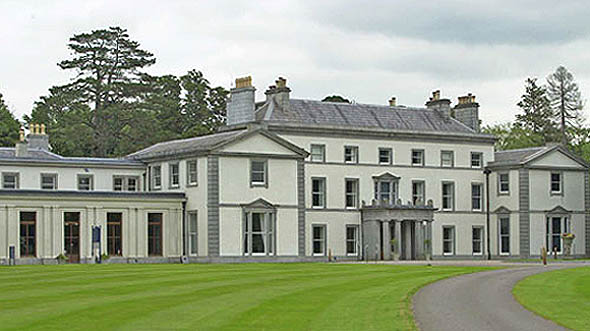
John Smith-Barry (1793-1837) was the grandfather of both Cecil Smith-Barry ( Pauline Barry[nee Roche]’s son in law, and also Arthur Smith-Barry, Lord Barrymore. In turn, John’s great-grandfather, James Barry, (1667-1748) was the 4th Earl of Barrymore. Pauline Roche (1835 -1894) has been part of the story for a while, she married William Henry Barry in 1857. I’m becoming increasingly sure that she helps place a lot of things into context. This is one of a series of posts covering her marriage into the Barry family, and her daughter’s marriage into the related Smith-Barrys, and a look at where they all fit into both Irish, and British society. Pauline Roche is Ernest O’Bryen’s first cousin
John Smith-Barry’s (1793-1837) father, James Hugh Smith Barry (1748-1801) had inherited Belmont Hall, in Cheshire, on the death of his father John Smith Barry in 1784, and lived there until he also inherited the family’s estates in Ireland, and the Marbury estate, also in Cheshire, on the death of his uncle Richard Barry in 1787. James had travelled widely in Europe and the Middle East, as a young man on the Grand Tour, between 1771-6, borrowing large amounts of money and amassing a huge collection of ancient statuary, vases and paintings, mostly by Italian masters. The collection was initially housed in Belmont Hall, until it was sold. James Hugh Smith Barry spent little time at Marbury but clearly intended to make changes to the Hall. In his twenty eight page will of July 1799, eventually found in a trunk at Belmont Hall, he directed his executors to catalogue his collection and remove it to Marbury, providing it with a gallery and custodian. He also willed that all his five children, whose mother was Ann Tanner, be made legitimate and known as Smith Barry. James Hugh Smith Barry died in 1801, two years after making his will, but it wasn’t until 1814 that John Smith-Barry fully inherited the estates.
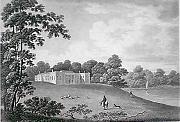
John Smith Barry (1793-1837) James Hugh Smith Barry’s eldest son, inherited the family’s estates at Marbury in Cheshire, and in Ireland in 1814. He preferred to live on the family estates in Ireland, in co. Cork, and co. Tipperary, and chose to live at Fota House, co.Cork. Fota House was originally a two-storey hunting lodge set in a large estate near to Barryscourt Castle. When the Barrymore’s family home was at Castlelyons, they used Fota as a base for fishing, shooting and yachting. John Smith Barry commissioned the architect, Sir Richard Morrison to create the current house in the 1820’s and the family made Fota House their main residence.
John Smith-Barry was born illegitimately in 1793. He was the eldest son of James Hugh Smith-Barry (1748-1801). He married, firstly, Eliza Mary Courtenay, daughter of Robert Courtenay, on 21 April 1814. She died on 16 April 1828. John Smith-Barry’s sister Caroline married Eliza Courtenay’s brother George. John Smith-Barry had a second childless marriage to Mary Felicia Heron in September 1835. He died on 24 February 1837. John, and Eliza had five children.
- James Hugh Smith-Barry b. 27 Jan 1816, d. 31 Dec 1856. (Father of Arthur Hugh SB 1843-1925-Lord Barrymore)
- Anne Smith-Barry b. 14 Mar 1817 d. 8 Dec 1834 unmarried.
- John Smith-Barry b. 25 Sep 1818 d. 9 Apr 1834 unmarried.
- Captain Robert Hugh Smith-Barry b. 13 Jan 1820, d. 25 Apr 1849 unmarried.
- Captain Richard Hugh Smith-Barry b. 21 Feb 1823, d. 23 Jan 1894 (father of Cecil Smith-Barry 1863 -1908)
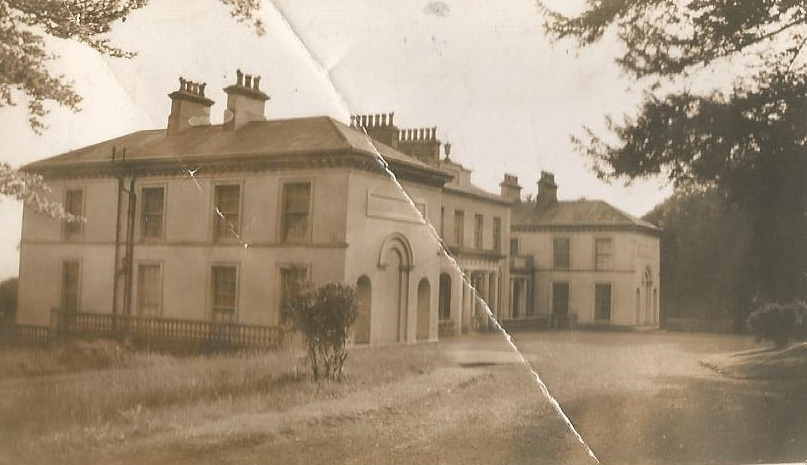
James Hugh Smith-Barry (1816-1856) inherited both Marbury Hall, and Fota House on the death of his father in 1837. His mother’s family,the Courtenays, owned Ballyedmond, in Midleton, co. Cork, which was inherited in turn by Eliza Courtenay’s brothers, George, and then John. John Courtenay, who appeared to be unmarried, left Ballyedmond to his nephew [and James Hugh’s youngest brother] Richard Smith-Barry in 1861. He, in turn, leaves it to his son Robert Courtenay Smith-Barry [Cecil Smith-Barry’s eldest brother], who, in turn, leaves it to his nephew Guy Forster/Smith-Barry on his death in 1930.
John Smith-Barry’s sisters all appear to marry well. But they are without doubt part of the Ascendancy.
Narcissa Smith-Barry married Hon. George William Massy, the second son of Hugh Massy, 3rd Baron Massy of Duntrileague on 28 April 1821.She drowned on 9 January 1831.The Massys were a Protestant Ascendancy family who had come to Ireland in 1641 and owned extensive lands in Counties Limerick, Leitrim and Tipperary.They were also Irish politicians, and George’s grandfather, and great-grandfather had both been M.P.’s for Limerick, and Hugh Massy, George’s great-grandfather, received his peerage in 1776. George’s great-nephew John Thomas, 6th Baron Massy inherited Killakee House, Killakee, co. Dublin from an aunt in 1880.
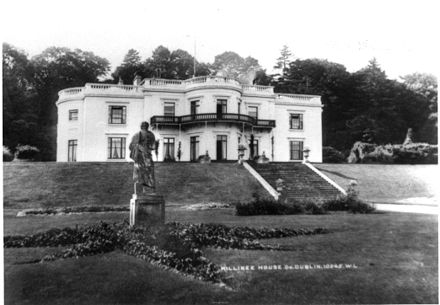
He used the house to entertain visitors while shooting game at Cruagh and Glendoo and to host parties where long lines of guest’s carriages could be seen stretched along the road leading to the house. Lord Massy employed a small army of staff, ranging from coachmen, stablemen, house servants, gardeners, cooks, and gamekeepers. During shooting expeditions, large dining shelters would be set up in the woods, where shooting parties would adjourn for lunch. Tables would be laid out there with the finest tableware, and food would be transported in pony carts from Killakee House. It was during this time that that the family’s riches reached its peak and, ironically, when it started to decline. By the time Lord Massy died in 1915, the estate was hopelessly in debt to the bank.
John Thomas’s grandson, Hugh Hamon Massy, next inherited Killakee. Hamon Massy was faced with a serious crisis, with the magnificent gardens alone requiring a large number of outdoor workers and gardeners. Massy still attended social events and drove around in the last of his grandfather’s motor cars, but by 1919, huge quantities of silver plates, jewellery, furniture, and a large art collection were sold in an auction that lasted several days. It soon became clear to the bank that the family were unable to deal with their financial problems. In May 1924 an officer and two assistants arrived to take possession of Killakee House. Massy, who was unwell, was lifted out of the house on his mattress and deposited on the nearby public road. The incident was widely reported in the national newspapers and the bank soon placed a caretaker in the house. By agreement with the bank, the family was later permitted to take possession of Beehive Cottage, a three-roomed gate lodge located near the gate to Killakee House. For thirty-four years following his eviction he was regularly seen collecting timber for his kitchen fire in the nearby woods. In 1941 the bank, unable to find a buyer, sold the house to a builder who salvaged what was left of Killakee House. Having removed the slates, timbers and floors, the builder demolished the house, in the sight of Hamon Massy who was still living in the nearby gate house. The woods were taken over by the forestry department and Massy was employed in a charcoal making business in the nearby forest.
Caroline Augusta Smith-Barry married George Courtenay on 29 July 1814. She died on the 28th May 1853. They lived at Ballyedmond, in co. Cork. George held the office of High Sheriff of County Cork in 1826, the year after his brother-in-law John Smith-Barry. George Courtenay was the son of Robert Courtenay and Catherine Nash and d. 10 Dec 1837. George Courtenay and Caroline SB have one daughter Caroline Augusta Courtenay who married Mountifort Longfield in 1840. He sounds like a parody of an appalling landowner.
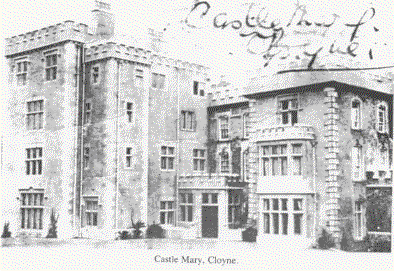
The Longfields lived at Castle Mary, co Cork. There are many stories told in the country side that crept into the folklore. Mountiford is depicted as ill-natured and very selfish. He did not allow any to walk on his land and the story goes that a priest in the area would still always walk this way even in spite of the restrictions the story becomes something like Jack of the beanstalk and the giant. Children were not allowed to pass through to get to school.The other story is that he rode over a child that was playing in the road with his horse when he was on his way to Ballycotton.He was very hard on his tenants and evicted them if they were unable to pay the rent and destroyed their homes. 35 homes were demolished. In a newspaper article it states that 73 families were evicted that is 378 people. He also received criticism for contributing £5 to the famine relieve fund which he later denied. Mountiford married Caroline Augusta in 1840 and had 13 children – only one son. Mountiford (1858-1929) educated in Eton and Oxford. He married Alice Elizabeth Mason (1865-1946) in 1891 who had a sizable dowry.(She is often described as being forceful) In 1920 on Sunday night 19 September the estate was burned. Allegedly by the IRA from the village Ballinacurra. The possible reasons mentioned – Col Longfield did not contribute to the IRA war fund. Or that the estate may be used as military barracks or tit-for-tat burnings. The Longfields were not at home at the time and there was only a small staff present, losses were £50,000. Apparently the family was devistated as the three girls considered themselves as Irish girls. With his death the male line of Longfields came to an end. After his death much of the estate was sold. Mountiford was very disappointed when his third daughter was also a girl as he wanted a son and heir but she – Cynthia was lively and pretty. Of his three daughters Cynthia Longfield became world renown for her research on dragonfly’s. This bit is from housetorian
George Courtenay left the Ballyedmond estate to his brother John, on his death in 1837, and John left the estate to Richard Smith-Barry, his sister Eliza’s youngest son in 1861. Robert Smith-Barry seems to be living at Ballyedmond, with Sara Louise Johnston, a widow six years older than he is, in both the 1901, and 1911 censuses.
Louisa Smith-Barry married Rt. Hon. Thomas Berry Cusack-Smith, son of Sir William Cusack-Smith, the 2nd Baronet., on 7 September 1819. They had one son, William and five daughters, Hester, Marianne, Anne, Caroline and Frances. He died on 13 August 1866, at their home, 8 Merrion Square, Dublin; now the headquarters of The Royal Institute of the Architects of Ireland. She died on 18 April 1872.
In a slightly curious irony, Sir Thomas Berry Cusack-Smith, who, as the Master of the Rolls in Ireland, heard the appeal on Pauline Roche’s case in 1855, later became Mary Barry’s great-uncle. His wife Louisa was Mary’s husband Cecil Smith Barry’s great-aunt. Mary Smith-Barry (nee Barry) was one of Pauline and William Barry’s daughters.
Sir Thomas Berry Cusack-Smith PC (1795 – 13 August 1866) was an Irish politician and judge. He was nicknamed “TBC Smith” or “Alphabet Smith”. He was the younger son of Sir William Cusack-Smith, 2nd Baronet, Baron of the Exchequer and his wife Hester Berry, and grandson of Sir Michael Smith, 1st Baronet, Master of the Rolls in Ireland from 1801 to 1806. He was educated at Trinity College, Dublin, entered Lincoln’s Inn in 1817 and was called to the Irish Bar in 1819. He was briefly Member of Parliament for Ripon (1843 -1846).
Thomas Cusack-Smith followed in his father’s footsteps as Solicitor-General in Ireland, and his grandfather’s footsteps to become Master of the Rolls in Ireland. Like his father, Thomas was a notable eccentric. He was appointed Solicitor-General for Ireland briefly in 1842, and then Attorney-General for Ireland from 1842 until 1846, in which role he prosecuted Daniel O’Connell at his trial on charges of conspiracy, sedition, and unlawful assembly.
His conduct of the O’Connell trial attracted severe criticism, and the House of Lords later quashed the guilty verdict for gross irregularities. Like his father he had a reputation for eccentricity and bad temper: during the trial of Daniel O’Connell he challenged one of the opposing counsel, Gerald Fitzgibbon, to a duel, for having allegedly accused him of acting from “private and dishonourable motives”. The Lord Chief Justice, Edward Pennefather, suspended the proceedings, in order to afford the parties time for reflection, observing that “the Attorney-General is the last man in his profession who ought to have allowed himself to be betrayed into such an expression of feeling as has been stated to have taken place.” The judges, gravely embarrassed, strongly criticised Cusack-Smith for his actions and persuaded him to drop the matter.
His frequent outbursts of bad temper were often attributed to chronic indigestion. An admirer described him as having “a touch of genius” but admitted he was rough and harsh in manner. Charles Gavan Duffy described him as “dignified” but so unhealthy and ghastly in appearance as to resemble “an owl in daylight”. Daniel O’Connell called him “the vinegar cruet”.
Thomas’s father, William Cusack-Smith had also had his run-ins with Daniel O’Connell. William was an eccentric judge who offended Daniel O’Connell so much, he raised a motion in the House of Commons, carried by MPs on 13 February 1834, to appoint a select committee to enquire into the conduct of Lord Smith in respect of his neglect of duty as a judge, and the introduction of political topics in his charges to grand juries. On the count of neglect, Cusack-Smith had been accused of rarely beginning his court sessions until after noon, occasionally running them until late into the night. The accusation of introducing political topics stemmed from statements made from the bench to grand juries condemning partisan agitation practices that were, that were themselves perceived as inflammatory due to their one-sided nature. The resolution to appoint the committee was rescinded by a majority of six, a week later.
- James Smith-Barry (1798 – 1861) lived at Lota Lodge, died without issue 29th October 1861 aged 63. James Smith, s. James Hugh, of Dublin (city), arm. Brasenose Coll., matric 7 July, 1815, aged 17 ; of Lota Lodge, co. Cork, died s.p. from Alumni Oxoniensis (1715-1886). He appears to have married yet another Eliza Smith Barry.